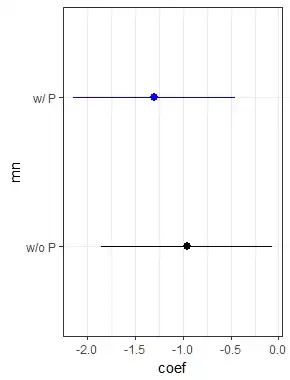I want to find out if the influence of potential mediator P on treatment effect D is significant. In the two models below $\beta_1$ and $\lambda_1$ are different and I don't know how to test if the difference is significant. Consider D as a perfect random assignment.
$$\hat{y} = \beta_0 + \beta_1D + \epsilon$$
and
$$\hat{y} = \lambda_0 + \lambda_1D + \lambda_2P + \mu$$
I could find a lot of answers comparing differences between two groups. Since I'm considering only one group I think this problem has not been answered before.
I give following example.
Data example
df1 <- structure(list(Y = c(5, 8, 6, 7, 8, 8, 10, 6, 7, 7, 5, 7, 8,
7, 7, 5, 8, 6, 7, 5, 10, 10, 6, 7, 4, 7, 9, 8, 2, 6, 6, 5, 6,
6, 6, 7, 6, 4, 7, 2, 6, 5, 8, 7, 5, 6, 6, 8, 6, 6), P = c(5,
5, 4, 5, 5, 4, 5, 5, 4, 5, 4, 5, 5, 4, 3, 4, 5, 3, 5, 5, 5, 5,
4, 4, 2, 6, 6, 5, 4, 5, 5, 4, 5, 6, 5, 5, 5, 4, 5, 6, 5, 2, 5,
4, 4, 5, 5, 6, 4, 5), D = c(0, 0, 0, 0, 0, 0, 0, 0, 0, 0, 0,
0, 0, 0, 0, 0, 0, 0, 0, 0, 0, 0, 0, 0, 0, 1, 1, 1, 1, 1, 1, 1,
1, 1, 1, 1, 1, 1, 1, 1, 1, 1, 1, 1, 1, 1, 1, 1, 1, 1)), .Names = c("Y",
"P", "D"), row.names = c("159.31", "174.31", "106.31", "264.31",
"424.31", "371.31", "379.31", "399.31", "177.31", "269.31", "133.31",
"89.31", "78.31", "385.31", "130.31", "330.31", "260.31", "406.31",
"278.31", "455.31", "245.31", "225.31", "285.31", "173.31", "447.31",
"310.3", "251.3", "337.3", "122.3", "229.3", "362.3", "241.3",
"151.3", "140.3", "398.3", "402.3", "169.3", "152.3", "219.3",
"283.3", "110.3", "359.3", "442.3", "354.3", "415.3", "105.3",
"246.3", "459.3", "113.3", "161.3"), class = "data.frame")
Models
s0 <- summary(f0 <- lm(Y ~ D , df1))
s1 <- summary(f1 <- lm(Y ~ D + P , df1))
> texreg::screenreg(list(f0, f1))
================================
Model 1 Model 2
--------------------------------
(Intercept) 6.96 *** 3.55 **
(0.32) (1.14)
D -0.96 * -1.30 **
(0.46) (0.43)
P 0.77 **
(0.25)
--------------------------------
R^2 0.08 0.24
Adj. R^2 0.07 0.21
Num. obs. 50 50
RMSE 1.61 1.49
================================
*** p < 0.001, ** p < 0.01, * p < 0.05
Taking P into the model P is significant and D is augmented. Very well. But how can I test if this augmentation is significant?
When I plot the coefficients the confidence intervals do overlap.
Plot
m <- rbind(data.frame(var="D", coef=coef(s0)[2, 1], se=coef(s0)[2, 2], mn="w/o P"),
data.frame(var="D", coef=coef(s1)[2, 1], se=coef(s1)[2, 2], mn="w/ P"))
library(ggplot2)
library(ggstance)
ggplot(m, aes(color=mn)) +
geom_pointrangeh(aes(y=mn, x=coef, xmin=coef - se*1.96, xmax=coef + se*1.96)) +
theme_bw() + scale_color_manual(values=c("black", "blue")) +
guides(color=FALSE)
But I suppose the overlap is not an ultimate proof that there's no significant difference between the two models, though.
An anova() test between both models only would show me if P is significant. But I need to test if the shift of D is significant. How would I do that?
With my real data the AIC difference between both models is $39>2$. According to a "rule of thumb" mentioned in an answer this could be evidence of significant difference. Such a statement would be very thin, though, and I'm not sure.
How can I test if the augmented treatment effect is significant?
